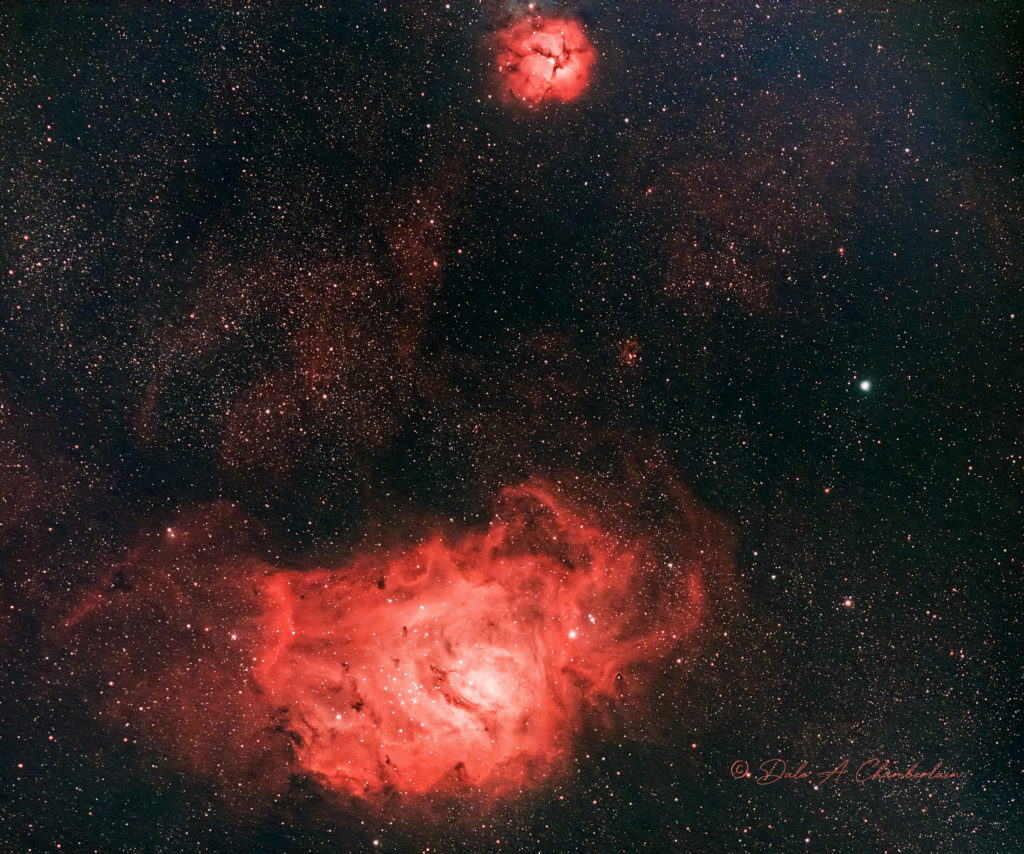
Object: This image is of two nebulae.
The upper nebula is the Trifid nebula (cataloged as Messier 20 or M20 and as NGC 6514) is an H II region located in Sagittarius. It was discovered by Charles Messier on June 5, 1764. Its name means ‘divided into three lobes’. The object is an unusual combination of an open cluster of stars; an emission nebula (the lower, red portion), a reflection nebula (the upper, blue portion) and a dark nebula (the apparent ‘gaps’ within the emission nebula that cause the trifurcated appearance; these are also designated Barnard 85). Viewed through a small telescope, the Trifid Nebula is a bright and peculiar object and is thus a perennial favorite of amateur astronomers. It is approximately 5000 light-years away from Earth.
The lower nebula is the Lagoon Nebula (cataloged as Messier 8 or M8, NGC 6523, Sharpless 25, RCW 146, and Gum 72) and is a giant interstellar cloud in the constellation Sagittarius. It is classified as an emission nebula and as an H II region. The Lagoon Nebula was discovered by Giovanni Hodierna before 1654 and is one of only two star-forming nebulae faintly visible to the naked eye from mid-northern latitudes. Seen with binoculars, it appears as a distinct oval cloudlike patch with a definite core.
The Lagoon Nebula is estimated to be between 4,000-6,000 light-years away from the Earth.
This was particularly challenging because of the illumination of the moon at 99.24%, the presence of clouds near the target, and the target is low in altitude, about 27 degrees from the horizon at the highest point.
Taken: August 4, 2020
Telescope: Skywatcher Esprit 80 ED Triplet APO Refractor
Mount: Paramount ME II unguided
Camera: ZWO ASI1600MC-Pro (cooled to -10C; unity gain) Bin 1×1.
Focuser: Starizona Micro Touch Autofocuser
Rotator: Optec Pixys LE camera field rotator
Filters used: Optolong L-eNhance Dual-Band Filter
Exposures: 52×120 sec. for a total exposure time of 1.7 hours; calibrated with 40 dark frames, 40 flat frames with 100 bias frames
Palette: RGB
Seeing Conditions:
Aquired using Sequence Generator Pro 3 and TheSkyX
Processed with PixInsight and Photoshop CC 2019 (Weighted Batch Pre-processing script used for calibration, evaluation, registration and integration of subframes)